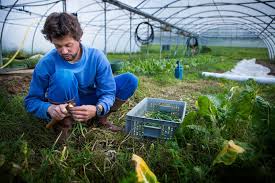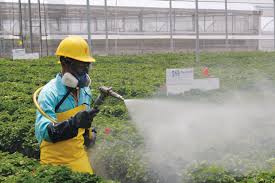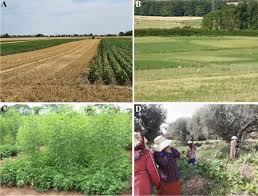Organic farming is a holistic approach to agriculture that emphasizes sustainable practices, environmental health, and social responsibility.
Unlike conventional farming, which often relies on synthetic chemicals and intensive farming methods, organic farming focuses on working with nature to produce food in a way that promotes biodiversity, enhances soil health, and conserves resources.
This method has gained popularity among consumers seeking healthier, chemical-free food options and is increasingly recognized for its potential to address environmental challenges.
Core Principles of Organic Farming
Organic farming is guided by several core principles that distinguish it from conventional practices:
1. Health: Organic farming aims to maintain and improve the health of soil, plants, animals, and humans. This holistic approach recognizes the interconnectedness of all living organisms and seeks to foster a healthy ecosystem.
2. Ecology: Organic practices are designed to work with natural systems. This includes promoting biodiversity, maintaining natural habitats, and using ecological processes to manage pests and diseases.
3. Fairness: Organic farming supports equitable relationships and social justice. It advocates for fair wages and working conditions for farmworkers and aims to create a sustainable food system that benefits everyone involved.
4. Care: Organic farming emphasizes the responsible management of resources. This includes protecting the environment, conserving biodiversity, and ensuring the welfare of animals and communities.
Soil Health and Fertility Management

Soil health is foundational to organic farming. Healthy soil is vital for growing strong, productive plants. Here are key practices for managing soil health and fertility:
1. Building Organic Matter: Adding organic materials such as compost, green manure, and cover crops improves soil structure, water retention, and nutrient availability. Organic matter enhances microbial activity, which is essential for nutrient cycling.
2. Crop Rotation: Rotating crops helps prevent soil depletion and break pest and disease cycles. Diverse crops contribute different nutrients and improve soil structure.
3. Minimal Tillage: Reducing soil disturbance through minimal tillage practices preserves soil structure, promotes microbial activity, and prevents erosion. This practice also helps retain moisture and reduces weed pressure.
4. Natural Fertilizers: Organic farmers use natural fertilizers like compost, animal manure, and mineral-based inputs to provide essential nutrients to plants. These fertilizers release nutrients slowly, supporting sustained plant growth.
5. Soil Testing: Regular soil testing allows farmers to monitor nutrient levels and pH, enabling them to make informed decisions about soil amendments and fertility management.
Biodiversity in Organic Farming
Biodiversity is a crucial element of organic farming. Promoting a diverse ecosystem leads to healthier crops and a more resilient farming system. Here are key aspects of biodiversity in organic farming:
1. Crop Diversity: Growing a variety of crops increases resilience to pests and diseases, improves soil health, and enhances the ecosystem. Mixed cropping can lead to better yields and reduce the need for chemical inputs.
2. Habitat Preservation: Organic farms often maintain natural habitats, such as hedgerows, wetlands, and wildflower strips, which support beneficial insects and wildlife. These habitats provide natural pest control and pollination services.
3. Livestock Diversity: Raising different livestock breeds can enhance farm resilience and contribute to soil fertility through manure. Diverse animal species also promote a balanced ecosystem.
4. Agroforestry Practices: Integrating trees and shrubs into farming systems enhances biodiversity, improves soil health, and provides additional products, such as fruit and timber.
5. Native Plants: Incorporating native plants into organic farms supports local biodiversity and provides habitat for beneficial organisms. These plants can also serve as natural pest deterrents.
Read Also: How to know the Best Specie of Fish to Raise
Pest and Disease Management

Effective pest and disease management is essential for maintaining healthy crops in organic farming. Here are key strategies used in organic pest and disease management:
1. Integrated Pest Management (IPM): IPM combines multiple strategies to control pests sustainably. This includes cultural practices, biological control, and the use of organic-approved pesticides.
2. Crop Rotation and Diversity: As mentioned earlier, rotating crops and planting diverse species help break pest and disease cycles, reducing reliance on chemical control measures.
3. Natural Predators: Encouraging beneficial insects, such as ladybugs and lacewings, can help control pest populations naturally. Providing habitats for these predators enhances their presence on the farm.
4. Mechanical Controls: Physical methods, such as traps and barriers, can be effective in managing pests. Hand-picking pests, using insect nets, and employing row covers are common practices in organic farming.
5. Resistant Varieties: Choosing plant varieties that are resistant to common pests and diseases can reduce the need for intervention and improve crop resilience.
6. Monitoring and Scouting: Regularly inspecting crops for pests and diseases allows farmers to identify problems early and take appropriate action before they escalate.
Sustainable Water Management in Organic Farming
Sustainable water management is crucial for organic farming, as it helps conserve resources, maintain soil health, and ensure healthy crop production. Here are key practices for sustainable water management:
1. Rainwater Harvesting: Collecting rainwater from roofs and surfaces can provide a valuable source of irrigation water. This practice reduces dependency on municipal water supplies and helps farmers manage water resources effectively.
2. Drip Irrigation: This method delivers water directly to the root zone of plants, minimizing evaporation and runoff. Drip irrigation is efficient, reduces water waste, and improves crop yields.
3. Soil Moisture Monitoring: Using moisture sensors helps farmers determine when to irrigate, preventing overwatering and ensuring that plants receive adequate moisture. This practice conserves water and promotes healthy growth.
4. Mulching: Applying organic mulch around plants helps retain soil moisture, reduce evaporation, and suppress weeds. Organic materials like straw, wood chips, or grass clippings can enhance soil health while conserving water.
5. Contour Farming: Planting crops along the contours of the land helps reduce soil erosion and improve water retention. This technique promotes effective water management and enhances soil fertility.
Read Also: The Most Lucrative between Production of Fish Fingerlings or Raising them to Table Size
Crop Rotation and Diversification

Crop rotation and diversification are essential practices in organic farming that contribute to soil health, pest management, and increased biodiversity. Here’s how they work:
1. Crop Rotation: Rotating different crops in a specific sequence each growing season helps prevent soil nutrient depletion, reduces pest and disease cycles, and improves soil structure. For example, following a nitrogen-fixing legume with a nitrogen-demanding crop enhances soil fertility.
2. Intercropping: Growing two or more crops together in the same field can improve yields and reduce pest pressure. Complementary crops, such as corn and beans, can benefit each other, maximizing land use and increasing biodiversity.
3. Cover Crops: Planting cover crops during the off-season protects the soil from erosion, improves soil structure, and enhances fertility. Cover crops, such as clover or rye, can also suppress weeds and attract beneficial insects.
4. Diversity in Planting: Including a variety of plant species in a farming system enhances ecosystem resilience, attracts beneficial organisms, and reduces the risk of crop failure due to pests or diseases.
5. Enhanced Pollination: Crop diversification provides habitats for pollinators and beneficial insects, leading to improved pollination and higher crop yields.
Organic Certification and Standards
Organic certification ensures that farming practices meet specific standards, promoting consumer confidence in organic products. Here are key points about organic certification:
1. Certification Process: Farmers seeking organic certification must follow strict guidelines set by certifying bodies. This process typically involves submitting an application, undergoing an inspection, and maintaining detailed records of farming practices.
2. Standards for Inputs: Organic farming standards prohibit the use of synthetic fertilizers, pesticides, and genetically modified organisms (GMOs). Instead, organic farmers must use natural inputs, such as compost and biological pest control.
3. Record-Keeping: Organic farmers are required to keep detailed records of their practices, including seed sources, input use, crop rotation schedules, and pest management strategies. This documentation is essential for maintaining certification.
4. Transition Period: Newly converting farms must go through a transition period (usually three years) during which they follow organic practices but cannot sell their products as organic until the transition is complete.
5. Certification Bodies: Various organizations and agencies, such as the USDA in the United States and the Soil Association in the UK, oversee organic certification. Farmers must comply with the specific requirements of their certifying body.
Challenges in Organic Farming
While organic farming has numerous benefits, it also faces several challenges that farmers must navigate. Here are some common challenges:
1. Pest Management: Organic farmers often face pest and disease pressures without the use of synthetic pesticides. This requires careful monitoring and the implementation of integrated pest management strategies, which can be labor-intensive.
2. Soil Fertility Management: Maintaining soil fertility without synthetic fertilizers can be challenging. Organic farmers must rely on compost, cover crops, and crop rotations, which require careful planning and knowledge of soil health.
3. Certification Process: Obtaining organic certification can be a lengthy and complex process, which may deter some farmers. The need for meticulous record-keeping and adherence to standards can also be daunting.
4. Market Access: Organic farmers may face challenges in accessing markets and competing with lower-priced conventional products. Building relationships with consumers and retailers is essential for success.
5. Weather Variability: Organic farms, like all agricultural systems, are vulnerable to climate change and extreme weather events. Farmers must adapt their practices to mitigate the impacts of droughts, floods, and temperature fluctuations.
6. Labor Costs: Organic farming can be more labor-intensive than conventional farming due to practices like hand-weeding, manual harvesting, and careful monitoring. This can lead to higher labor costs and affect profitability.
Organic farming is a sustainable agricultural approach that prioritizes soil health, biodiversity, and responsible resource management.
By implementing practices like sustainable water management, crop rotation, and adhering to organic certification standards, organic farmers can produce high-quality food while addressing the challenges of modern agriculture.
As consumer demand for organic products continues to grow, understanding and overcoming these challenges will be crucial for the future of organic farming.
Do you have any questions, suggestions, or contributions? If so, please feel free to use the comment box below to share your thoughts. We also encourage you to kindly share this information with others who might benefit from it. Since we can’t reach everyone at once, we truly appreciate your help in spreading the word. Thank you so much for your support and for sharing!
Read Also: Succulent Plants: A Guide to Growing and Caring for These Unique Plants






